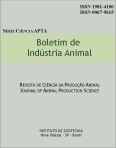Artificial infestation with Rhipicephalus (boophilus) microplus tick and food intake and corporal condition in resistant and susceptible cattle
Keywords:
cattle, food intake, body conditionAbstract
The cattle-tick Rhipicephalus (Boophilus) microplus is one of the worst pests of domestic livestock due to damages caused to the health. Artificial infestation is still needed in many scientific papers, and, depending on the quantity of infesting larvae and the cattle susceptibility, it can be fatal due to the deleterious effects that this parasite causes to the cattle health. The food intake greatly decreases during massive larval infestations. The objective of this work was to study the impact of an artificial infestation on feed intake and animal body condition. Four susceptible cattle (Holstein Black and White) were infested with 10,000 larvae and 20,000 larvae infested six resistant cattle (Nellore). Animals were an average of 7 months-old. Two weeks before the infestation and during the parasitic life cycle (three weeks after the infestation), each animal was placed in individual pens with water and food ad libitum. It was offered 2 kg of commercial concentrate (minimum 16% crude protein, CP) and 5 kg of Cynodon dactylon cv. Tifton (13.19% CP) a day. The refusal was weighed for 3 consecutive days at the time of: one week before infestation, and one, two and three weeks post-infestation in order to calculate food intake average before and during the life cycle of the parasite. Animals were assessed for body condition (1 - skinny to 5 - obese) weekly. The experimental design was a non-probability sample restricted to 10 animals. Food intake data was analyzed using general linear models (SPSS® statistical package -version 12.0) with breed and day as independent variable. Both effects were significant (P<0.01). Food intake (FI) increased in both breeds, higher in Holstein (5.962 ± 0.154 kg food day-1 versus 5.392 ± 0.126 kg food day-1, for Nellore). The regression of body condition score (BC) was calculated as a function of FI. The body condition from animals of both breeds increased as the food intake was enlarged over the three weeks of parasitic cycle (BC = 3.104 + 0.154 FI €“ 1.083 Breed, R2 = 0.675). Therefore, it was concluded that artificial infestations with 10,000 larvae in susceptible cattle and 20,000 in resistant cattle did not harmed food intake or body condition. So, we can recommend this amount of larvae for resistant and susceptible cattle in experiments which require tick€™s artificial infestation.Downloads
Downloads
Published
Issue
Section
License
Os autores não serão remunerados pela publicação de trabalhos, pois devem abrir mão de seus direitos autorais em favor deste periódico. Por outro lado, os autores ficam autorizados a publicar seus artigos, simultaneamente, em repositórios da instituição de sua origem, desde que citada a fonte da publicação original seja Boletim de Indústria Animal. A revista se reserva o direito de efetuar, nos originais, alterações de ordem normativa, ortográfica e gramatical, com vistas a manter o padrão culto da língua e a credibilidade do veículo. Respeitará, no entanto, o estilo de escrever dos autores. Alterações, correções ou sugestões de ordem conceitual serão encaminhadas aos autores, quando necessário. Nesses casos, os artigos, depois de adequados, deverão ser submetidos a nova apreciação. As opiniões emitidas pelos autores dos artigos são de sua exclusiva responsabilidade. Todo o conteúdo deste periódico, exceto onde está identificado, está licenciado sob a Licença Creative Commons Attribution (CC-BY-NC). A condição BY implica que os licenciados podem copiar, distribuir, exibir e executar a obra e fazer trabalhos derivados com base em que só se dão o autor ou licenciante os créditos na forma especificada por estes. A cláusula NC significa que os licenciados podem copiar, distribuir, exibir e executar a obra e fazer trabalhos derivados com base apenas para fins não comerciais.













